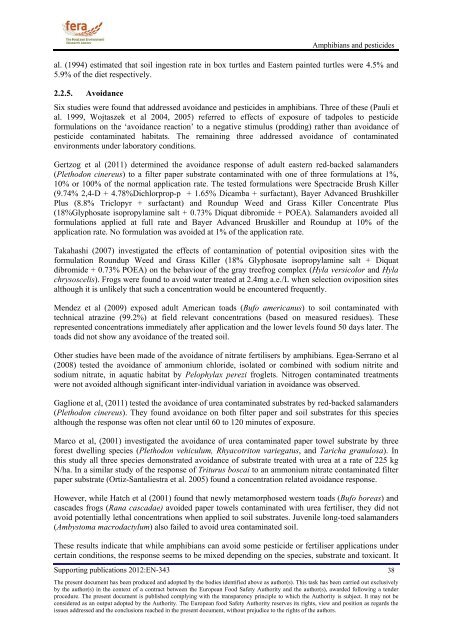The exposure and toxicity of pesticides to amphibians
The exposure and toxicity of pesticides to amphibians
The exposure and toxicity of pesticides to amphibians
Create successful ePaper yourself
Turn your PDF publications into a flip-book with our unique Google optimized e-Paper software.
Amphibians <strong>and</strong> <strong>pesticides</strong><br />
al. (1994) estimated that soil ingestion rate in box turtles <strong>and</strong> Eastern painted turtles were 4.5% <strong>and</strong><br />
5.9% <strong>of</strong> the diet respectively.<br />
2.2.5. Avoidance<br />
Six studies were found that addressed avoidance <strong>and</strong> <strong>pesticides</strong> in <strong>amphibians</strong>. Three <strong>of</strong> these (Pauli et<br />
al. 1999, Wojtaszek et al 2004, 2005) referred <strong>to</strong> effects <strong>of</strong> <strong>exposure</strong> <strong>of</strong> tadpoles <strong>to</strong> pesticide<br />
formulations on the ‘avoidance reaction’ <strong>to</strong> a negative stimulus (prodding) rather than avoidance <strong>of</strong><br />
pesticide contaminated habitats. <strong>The</strong> remaining three addressed avoidance <strong>of</strong> contaminated<br />
environments under labora<strong>to</strong>ry conditions.<br />
Gertzog et al (2011) determined the avoidance response <strong>of</strong> adult eastern red-backed salam<strong>and</strong>ers<br />
(Plethodon cinereus) <strong>to</strong> a filter paper substrate contaminated with one <strong>of</strong> three formulations at 1%,<br />
10% or 100% <strong>of</strong> the normal application rate. <strong>The</strong> tested formulations were Spectracide Brush Killer<br />
(9.74% 2,4-D + 4.78%Dichlorprop-p + 1.65% Dicamba + surfactant), Bayer Advanced Brushkiller<br />
Plus (8.8% Triclopyr + surfactant) <strong>and</strong> Roundup Weed <strong>and</strong> Grass Killer Concentrate Plus<br />
(18%Glyphosate isopropylamine salt + 0.73% Diquat dibromide + POEA). Salam<strong>and</strong>ers avoided all<br />
formulations applied at full rate <strong>and</strong> Bayer Advanced Bruskiller <strong>and</strong> Roundup at 10% <strong>of</strong> the<br />
application rate. No formulation was avoided at 1% <strong>of</strong> the application rate.<br />
Takahashi (2007) investigated the effects <strong>of</strong> contamination <strong>of</strong> potential oviposition sites with the<br />
formulation Roundup Weed <strong>and</strong> Grass Killer (18% Glyphosate isopropylamine salt + Diquat<br />
dibromide + 0.73% POEA) on the behaviour <strong>of</strong> the gray treefrog complex (Hyla versicolor <strong>and</strong> Hyla<br />
chrysoscelis). Frogs were found <strong>to</strong> avoid water treated at 2.4mg a.e./L when selection oviposition sites<br />
although it is unlikely that such a concentration would be encountered frequently.<br />
Mendez et al (2009) exposed adult American <strong>to</strong>ads (Bufo americanus) <strong>to</strong> soil contaminated with<br />
technical atrazine (99.2%) at field relevant concentrations (based on measured residues). <strong>The</strong>se<br />
represented concentrations immediately after application <strong>and</strong> the lower levels found 50 days later. <strong>The</strong><br />
<strong>to</strong>ads did not show any avoidance <strong>of</strong> the treated soil.<br />
Other studies have been made <strong>of</strong> the avoidance <strong>of</strong> nitrate fertilisers by <strong>amphibians</strong>. Egea-Serrano et al<br />
(2008) tested the avoidance <strong>of</strong> ammonium chloride, isolated or combined with sodium nitrite <strong>and</strong><br />
sodium nitrate, in aquatic habitat by Pelophylax perezi froglets. Nitrogen contaminated treatments<br />
were not avoided although significant inter-individual variation in avoidance was observed.<br />
Gaglione et al, (2011) tested the avoidance <strong>of</strong> urea contaminated substrates by red-backed salam<strong>and</strong>ers<br />
(Plethodon cinereus). <strong>The</strong>y found avoidance on both filter paper <strong>and</strong> soil substrates for this species<br />
although the response was <strong>of</strong>ten not clear until 60 <strong>to</strong> 120 minutes <strong>of</strong> <strong>exposure</strong>.<br />
Marco et al, (2001) investigated the avoidance <strong>of</strong> urea contaminated paper <strong>to</strong>wel substrate by three<br />
forest dwelling species (Plethodon vehiculum, Rhyacotri<strong>to</strong>n variegatus, <strong>and</strong> Taricha granulosa). In<br />
this study all three species demonstrated avoidance <strong>of</strong> substrate treated with urea at a rate <strong>of</strong> 225 kg<br />
N/ha. In a similar study <strong>of</strong> the response <strong>of</strong> Triturus boscai <strong>to</strong> an ammonium nitrate contaminated filter<br />
paper substrate (Ortiz-Santaliestra et al. 2005) found a concentration related avoidance response.<br />
However, while Hatch et al (2001) found that newly metamorphosed western <strong>to</strong>ads (Bufo boreas) <strong>and</strong><br />
cascades frogs (Rana cascadae) avoided paper <strong>to</strong>wels contaminated with urea fertiliser, they did not<br />
avoid potentially lethal concentrations when applied <strong>to</strong> soil substrates. Juvenile long-<strong>to</strong>ed salam<strong>and</strong>ers<br />
(Ambys<strong>to</strong>ma macrodactylum) also failed <strong>to</strong> avoid urea contaminated soil.<br />
<strong>The</strong>se results indicate that while <strong>amphibians</strong> can avoid some pesticide or fertiliser applications under<br />
certain conditions, the response seems <strong>to</strong> be mixed depending on the species, substrate <strong>and</strong> <strong>to</strong>xicant. It<br />
Supporting publications 2012:EN-343 38<br />
<strong>The</strong> present document has been produced <strong>and</strong> adopted by the bodies identified above as author(s). This task has been carried out exclusively<br />
by the author(s) in the context <strong>of</strong> a contract between the European Food Safety Authority <strong>and</strong> the author(s), awarded following a tender<br />
procedure. <strong>The</strong> present document is published complying with the transparency principle <strong>to</strong> which the Authority is subject. It may not be<br />
considered as an output adopted by the Authority. <strong>The</strong> European food Safety Authority reserves its rights, view <strong>and</strong> position as regards the<br />
issues addressed <strong>and</strong> the conclusions reached in the present document, without prejudice <strong>to</strong> the rights <strong>of</strong> the authors.

















